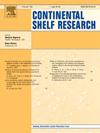基于实验与模拟的渤海湾盆地好氧带甲烷截留影响因素评价
IF 2.2
3区 地球科学
Q2 OCEANOGRAPHY
引用次数: 0
摘要
海洋沉积物是甲烷的储存库,甲烷是一种强有力的温室气体,也是一种有前途的清洁能源。当甲烷从深层迁移到浅层时,它与各种电子受体(如硫酸盐、硝酸盐和氧气)发生氧化还原反应。甲烷的有氧氧化(AeOM)在溶解氧可用的地方起着至关重要的作用,特别是在水深较浅的边缘海域。目前,对AeOM的研究还不够深入,尤其是定量研究。渤海油气盆地沉积物中甲烷泄漏较为普遍,具有甲烷氧化的条件。沉积物在氧化甲烷中起着重要的作用,是一个非常值得研究的课题。因此,我们利用AeOM的实验室数据,采用TOUGH + HR模拟平台,通过实验概念模型再现AeOM过程。利用采样和检测数据对微生物动力学参数进行标定,分析甲烷氧化特性。建立了动力学参数与温度之间的关系,便于参数估计。最大氧化速率(qm)与温度呈指数关系,而微生物衰变常数(b)与温度呈线性关系。定量分析了温度、压力、运移速度等不同影响因素下的甲烷氧化特征。结果表明,温度是决定甲烷消耗速率的关键因素,由于温度对微生物活性的影响,较高的温度导致甲烷消耗明显加快。4℃时平均氧化速率为0.35 μmol/d。该速率在10℃时增加到3.05 μmol/d,在15℃时进一步增加到3.96 μmol/d。当温度达到28℃时,浓度急剧上升至15.13 μmol/d。通过增加甲烷供应(溶解度),压力可以促进甲烷氧化消耗。压力增加1 MPa - 5 MPa,平均甲烷氧化率提高93%。甲烷运移速度主要影响甲烷的供给效率,50 μL/min ~ 150 μL/min速率可使甲烷供给效率提高10.3%。对比不同温度、压力和甲烷迁移速度的结果,我们认为温度和压力对甲烷氧化消耗有显著影响,而甲烷迁移速度没有显著影响。评价沉积物对甲烷氧化截留的影响应重点关注温度和压力的变化。该研究增强了对海底甲烷泄漏和海洋沉积物碳循环定量评价的认识。本文章由计算机程序翻译,如有差异,请以英文原文为准。
Evaluating influencing factors of methane interception in Bohai bay basin's aerobic zone based on experiment coupled with modeling
Marine sediments serve as reservoirs for methane, a potent greenhouse gas and a promising clean energy source. As methane migrates from deep to shallow layers, it undergoes oxidation-reduction reactions with various electron acceptors, such as sulfate, nitrate, and oxygen. Aerobic Oxidation of Methane (AeOM) plays a crucial role where dissolved oxygen is available, particularly in marginal seas with shallow water depths. For now, research on AeOM is not in-depth, especially quantitative works. In the Bohai Sea's petroleum and natural gas basins, methane leakage from sediments is common, and conditions for methane oxidation are present. The sediments play a significant role in oxidizing methane, presenting a highly worthwhile subject for research. Therefore, utilizing laboratory data on AeOM, we employed the TOUGH + HR simulation platform to reproduce the AeOM process by an experimental conceptual model. The calibration of microbial kinetic parameters was conducted using sampling and testing data to analyze the characteristics of methane oxidation. Moreover, relationships between kinetic parameters and temperature were established, facilitating parameter estimation. The maximum oxidation rate (qm) shows an exponential relationship with temperature, whereas the microbial decay constant (b) displays a linear relationship. We quantitatively analyzed the characteristics of methane oxidation under different influencing factors, including temperature, pressure, and gas migration velocity. The results revealed that temperature is a key factor in determining methane consumption rates, with higher temperatures leading to significantly faster methane consumption due to its influence on microbial activity. The average oxidation rate was recorded as 0.35 μmol/day at 4 °C. This rate increased to 3.05 μmol/day at 10 °C and further rose to 3.96 μmol/day at 15 °C. Notably, there was a dramatic jump to 15.13 μmol/day when the temperature reached 28 °C. By enhancing methane supply (solubility), pressure can boost methane oxidation consumption. 1 MPa–5 MPa pressure increase raises average methane oxidation rates by 93 %. Methane migration velocity primarily affects the supply efficiency of methane and a 50 μL/min to 150 μL/min velocity increase raises rates by 10.3 %. Compared with the results across various temperatures, pressures, and methane migration velocities, we believe that temperature and pressure have a significant impact on methane oxidation consumption, while methane migration velocity has no significant impact. The temperature and pressure changes should be focused on to evaluate the effect of sediment on methane oxidation interception. This study enhances the understanding of the quantitative assessment of seabed methane leakage and the marine sediment carbon cycle.
求助全文
通过发布文献求助,成功后即可免费获取论文全文。
去求助
来源期刊

Continental Shelf Research
地学-海洋学
CiteScore
4.30
自引率
4.30%
发文量
136
审稿时长
6.1 months
期刊介绍:
Continental Shelf Research publishes articles dealing with the biological, chemical, geological and physical oceanography of the shallow marine environment, from coastal and estuarine waters out to the shelf break. The continental shelf is a critical environment within the land-ocean continuum, and many processes, functions and problems in the continental shelf are driven by terrestrial inputs transported through the rivers and estuaries to the coastal and continental shelf areas. Manuscripts that deal with these topics must make a clear link to the continental shelf. Examples of research areas include:
Physical sedimentology and geomorphology
Geochemistry of the coastal ocean (inorganic and organic)
Marine environment and anthropogenic effects
Interaction of physical dynamics with natural and manmade shoreline features
Benthic, phytoplankton and zooplankton ecology
Coastal water and sediment quality, and ecosystem health
Benthic-pelagic coupling (physical and biogeochemical)
Interactions between physical dynamics (waves, currents, mixing, etc.) and biogeochemical cycles
Estuarine, coastal and shelf sea modelling and process studies.
 求助内容:
求助内容: 应助结果提醒方式:
应助结果提醒方式:


